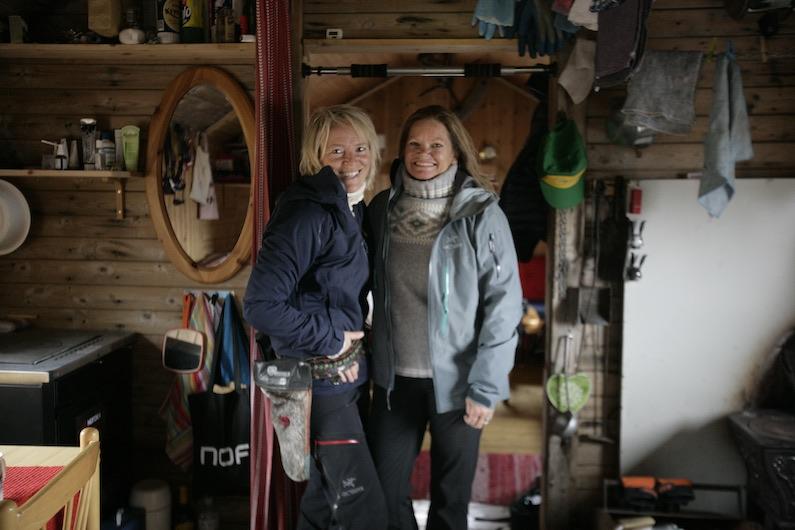Newsletter: Lifting the Gaze

Hilde Fålun Strøm has spent several months at Bjørnøya and Jan Mayen, and also two months in winter at Austfjordneset, north of Longyearbyen. Norwegian-Canadian Sunniva Sørby was the first woman to ski to the South Pole and she has also crossed Greenland, ran marathons and climbed high mountains. Photo credit Hearts in the Ice
Dear reader!
Sometimes it is important to lift one’s gaze and try to see the world from someone else’s perspective.
It is not always easy, each to his own, nevertheless; it becomes increasingly important in a world growing all the more protectionist and where international cooperation is under pressure everywhere.
We who live and work in the Arctic have a tendency to be provoked when non-Arctic states try to meddle in how we are to manage “our” lives and preserve “our” natural diversity.
US Foreign Minister Mike Pompeo in Rovaniemi earlier this year went far in stripping China of its legitimacy and right to speak out about Arctic affairs. “There are Arctic and non-Arctic states. There are no other alternatives” he said, amongst others.
It is everyone’s business
Yet it is worth pointing out that we all live on the same globe, and climate changes and the challenges they lead to do not discriminate across latitudes or national borders.
An increasing number of non-Arctic states adopt Arctic strategies. The last one to do so is Germany, which last week adopted new guidelines for its Arctic policy.
Why, do you ask?
Because they see that increased sea level based on ice melting in the Arctic may have significant consequences for Germany. And they see that climate changes already are affecting weather patterns in Europe.
However, like many non-Arctic states’ strategies, the German one does not differentiate between the Arctic countries.
Different perspectives
Can you blame them?
A couple of weeks ago, we were shocked with the news that Brazil’s president Jair Messias Bolsonaro did not want to receive the bag of money that was collected during the G7 meeting in order to assist with the extinguishing of the gigantic forest fires in the Amazon.
He changed his mind on the next day, mind you, but why is the world’s desire to help the Arctic gain control over the climate so much different?
It may be healthy to once in the while look at the Arctic in a more global context, not just as a region.
And even though the German’s deserve a pat on the shoulder for focusing on how they can contribute, there is nevertheless not much doubt that climate changes must be handled on a global scale.
Yet: “The dilemma nevertheless arises because the German worries about Arctic climate require setting national decisions aside in favor of international agreements. Establishing protected areas, agreements placing a ban on mining, and a more general demand for international agreements for use of the Arctic go far into violating the eight Arctic states’ independence and right of self-determination”, our Editor-in-Chief Arne O. Holm writes in this week’s Friday commentary.
China throttles on
In a budget leak from the Norwegian government today [Friday], we learned that Norway wants to improve communication in the High North and will set up two new base stations, one on Svalbard and one on the mainland, to that effect.
The Chinese also focus on this and China continues its efforts in the Arctic. Second only to Russia, China has been the most active country along the Northern Sea Route (NSR), and the Chinese national shipping company COSCO has shipped up to 30 vessels through the NSR over the last four years.
This week brought the news that the Chinese Ministry of Transportation is sending out a team that is to optimize the country’s communications capacity along the Russian coastline in Arctic waters.
While the official goal is to secure uninterrupted radio communication from the eastern and western turning points along the NSR to four different locations in China, experts fear that this technology can also be used for military purposes.
Marc Lanteigne, professor at UiT Norway’s Arctic University, says to High North News that worries about the Chinese developing a form of tactical spearhead on Greenland may be a partial explanation as to why the USA went on a quest to buy Greenland this August.
The USA is worried
More Chinese presence in the Arctic is a development against which the USA warns at every opportunity. The last occasion was Vice President Mike Pence’s visit to Iceland this week, where the Russian and Chinese initiatives in the Arctic were high on the agenda in the meetings with Icelandic authorities.
The USA will for instance invest 91 million dollars in extending the Keflavik airport facilities (on Iceland), where 5,000 American soldiers were based during the Cold War.
France and Denmark held a joint exercise off the coast of Greenland recently, and the Americans were also present.
And an important meeting took place in Russia this week. President Vladimir Putin met with Indian Prime Minister Modi in Vladivostok. During the visit, Putin and Modi signed a bilateral cooperation agreement declaring their desire to strengthen and further develop Russian-Indian cooperation when it comes to trade, investments and foreign policy, in particular aimed at natural resources and mineral exploitation in eastern Russia and the Arctic.
Adventures in the High North
Next Friday, Norwegian Hilde Fålun Strøm and Norwegian-Canadian Sunniva Sørby set out on a quite unique expedition. The two are to winter 140 kilometers south of Longeyarbyen, Svalbard, at a small cabin from the 1930s.
Their goal is to raise awareness about climate changes and sharing their experiences as well as knowledge they acquire through living isolated and on nature’s premises while also conducing measurements for scientists.
High North News wishes them the best of luck on their adventure – and a wonderful weekend to you!
Siri Gulliksen Tømmerbakke
News Editor, High North News
